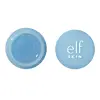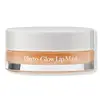What's inside
What's inside
 Key Ingredients
Key Ingredients

 Benefits
Benefits

 Concerns
Concerns

 Ingredients Side-by-side
Ingredients Side-by-side

Triisostearin
Skin ConditioningHydrogenated Polyisobutene
EmollientPolyglyceryl-10 Pentaisostearate
EmollientDextrin Palmitate
EmulsifyingEthylhexylglycerin
Skin ConditioningDiethylhexyl Syringylidenemalonate
Skin ProtectingSqualane
EmollientParfum
MaskingSimethicone
EmollientCaprylic/Capric Triglyceride
MaskingTocopherol
AntioxidantWater
Skin ConditioningRicinus Communis Seed Oil
MaskingGlycerin
HumectantSodium Hyaluronate
HumectantHydrogenated Castor Oil
Emollient1,2-Hexanediol
Skin ConditioningSoluble Collagen
HumectantLinalool
PerfumingGeraniol
PerfumingBenzyl Benzoate
AntimicrobialLimonene
PerfumingCI 77891
Cosmetic ColorantCI 42090
Cosmetic ColorantCI 45410
Cosmetic ColorantTriisostearin, Hydrogenated Polyisobutene, Polyglyceryl-10 Pentaisostearate, Dextrin Palmitate, Ethylhexylglycerin, Diethylhexyl Syringylidenemalonate, Squalane, Parfum, Simethicone, Caprylic/Capric Triglyceride, Tocopherol, Water, Ricinus Communis Seed Oil, Glycerin, Sodium Hyaluronate, Hydrogenated Castor Oil, 1,2-Hexanediol, Soluble Collagen, Linalool, Geraniol, Benzyl Benzoate, Limonene, CI 77891, CI 42090, CI 45410
Diisostearyl Malate
EmollientHydrogenated Poly(C6-14 Olefin)
EmollientPolybutene
Phytosteryl/Isostearyl/Cetyl/Stearyl/Behenyl Dimer Dilinoleate
Skin ConditioningCera Microcristallina
Emulsion StabilisingButyrospermum Parkii Butter
Skin ConditioningSynthetic Wax
AbrasiveAroma
Ethylene/Propylene/Styrene Copolymer
Persea Gratissima Oil
Skin ConditioningCopernicia Cerifera Cera
EmollientSimmondsia Chinensis Seed Oil
EmollientTheobroma Grandiflorum Seed Butter
Skin ConditioningSiraitia Grosvenorii Fruit Extract
Skin ConditioningRicinus Communis Seed Oil
MaskingAleurites Moluccanus Seed Oil
Skin ConditioningStearyl Glycyrrhetinate
Skin ConditioningTocopheryl Acetate
AntioxidantDiethylhexyl Syringylidenemalonate
Skin ProtectingButylene/Ethylene/Styrene Copolymer
Caprylic/Capric Triglyceride
MaskingPentaerythrityl Tetra-Di-T-Butyl Hydroxyhydrocinnamate
AntioxidantIsopropyl Titanium Triisostearate
EmollientCitric Acid
BufferingCI 77491
Cosmetic ColorantCI 77492
Cosmetic ColorantCI 77499
Cosmetic ColorantDiisostearyl Malate, Hydrogenated Poly(C6-14 Olefin), Polybutene, Phytosteryl/Isostearyl/Cetyl/Stearyl/Behenyl Dimer Dilinoleate, Cera Microcristallina, Butyrospermum Parkii Butter, Synthetic Wax, Aroma, Ethylene/Propylene/Styrene Copolymer, Persea Gratissima Oil, Copernicia Cerifera Cera, Simmondsia Chinensis Seed Oil, Theobroma Grandiflorum Seed Butter, Siraitia Grosvenorii Fruit Extract, Ricinus Communis Seed Oil, Aleurites Moluccanus Seed Oil, Stearyl Glycyrrhetinate, Tocopheryl Acetate, Diethylhexyl Syringylidenemalonate, Butylene/Ethylene/Styrene Copolymer, Caprylic/Capric Triglyceride, Pentaerythrityl Tetra-Di-T-Butyl Hydroxyhydrocinnamate, Isopropyl Titanium Triisostearate, Citric Acid, CI 77491, CI 77492, CI 77499
 Reviews
Reviews

Ingredients Explained
These ingredients are found in both products.
Ingredients higher up in an ingredient list are typically present in a larger amount.
This ingredient is an emollient, solvent, and texture enhancer. It is considered a skin-softener by helping the skin prevent moisture loss.
It helps thicken a product's formula and makes it easier to spread by dissolving clumping compounds.
Caprylic Triglyceride is made by combining glycerin with coconut oil, forming a clear liquid.
While there is an assumption Caprylic Triglyceride can clog pores due to it being derived from coconut oil, there is no research supporting this.
Learn more about Caprylic/Capric TriglycerideDiethylhexyl Syringylidenemalonate (DESM) is a photostabilizer, antioxidant, and SPF booster.
One of DESM's main roles is stabilizing UV filters, especially avobenzone. Avobenzone is notoriously unstable when exposed to sunlight. By enhancing the stability of these filters, DESM helps maintain the sunscreen's effectivess through wear. It also helps improve protection against long-wave UVA rays by increasing the wavelength of the formula.
Besides enhancing UVA protection, DESM can boost the SPF of high-SPF formulations by up to 5 units.
DESM also preserves the color integrity of cosmetic products and helps reduce the chance of yellowing of fading due to light exposure.
This ingredient is typically found in concentrations between 0.3% - 0.5%. There are currently no maximum usage limits by regulatory bodies.
Though this ingredient is a chemical UV filter, it can often be found in "100% mineral" sunscreens. This is due to regulatory loopholes.
Learn more about Diethylhexyl SyringylidenemalonateRicinus Communis Seed Oil is the INCI name for castor oil.
Castor Oil helps moisturize the skin. It is rich in a fatty acid called ricinoleic acid. This fatty acid helps prevent moisture loss on the skin. This helps keep your skin soft and hydrated. Ricinoleic acid also has anti-inflammatory and pain reducing properties.
Besides hydrating the skin, castor oil is also used to hydrate hair. By keeping the hair shaft moisturized, breakage is decreased. More studies are needed to show castor oil's effective on stimulating hair growth.
Castor oil is created by cold-pressing castor seeds and then purifying the oil with heat. It was used in Ancient Egypt as fuel in lamps and to help treat eye irritation.
The term 'fragrance' is not regulated in many countries. In many cases, it is up to the brand to define this term. For instance, many brands choose to label themselves as "fragrance-free" because they are not using synthetic fragrances. However, their products may still contain ingredients such as essential oils that are considered a fragrance.
Learn more about Ricinus Communis Seed Oil